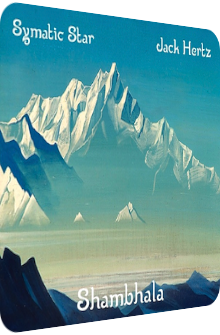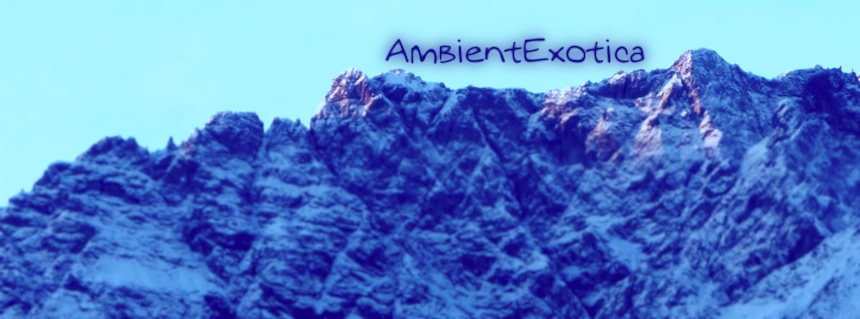
Symatic Star & Jack Hertz
Shambhala
2013
Shambhala is a collaborative work by Symatic Star aka Simon Walsh, multi-instrumentalist and synth wizard from South Western Australia, and San Francisco’s Ambient veteran and synthesist Jack Hertz. Sporting five long tracks, shuttling between Space Ambient and New Age frequently and without any distinctive borders, the digital-only work was fittingly released on Hertz's own Aural Films label in March 2013 and can be purchased (name your price) and fully streamed at Bandcamp. And an aural film the listener shall experience. The concept of the album draws from three eminent sources. The most important impact comes from the conglomeration of Tibetan and Mongolian stories about the mystical kingdom of Shambhala. In the album’s liner notes, the land of Shambhala is described "as a hidden valley with a line of enlightened kings guarding the highest wisdom, for a time when all harmony in the world outside will seem lost. According to some legends the King of Shambhala and his warriors will then emerge vanquishing the forces of evil and establishing a golden age." This golden age has yet to come in the album’s time-related boundaries, and so the second marker comprises of Russian painter and adventurer Nikolai Roerich’s 1933 painting Mount Of Five Treasures (Two Worlds) which unites the glowing insouciance of technicolor saturation with aggrieving mountain ranges and scantiness. The final and most important source is the feeling of being in a dreamlike, unreal state. Naturally, creating a dreamlike state is the very definition of Ambient in a nutshell to many, but in Shambhala Symatic Star and Jack Hertz draw from all the implications this notion inherits: wistfulness, aloofness, insecurity, awe, you name it. Instead of embracing the listening or traveling subject with open arms, Shambhala is an aural work with film noir elements, the most distinct of them being a trombone and a clarinet. Otherwise, there are synth constructions en masse and a rightful opportunity to finally use the archetypical Tibetan gongs, bells and whistles for good; they literally chime in. Despite its majestically meandering braiding, the album is a heavy affair, but luckily much more accessible than the very figment it thematizes. And it is glacial enough to be featured in my Winter Ambient Review Cycle 2013.
A prolonged or elasticized crystalline gong, partially dissonant and screeching strings shrouded in mystery, an empty hollowness in the background: the almost 17 minutes long Journey To Shambhala is a strikingly cinematic and deeply portentous work, showcasing an aural cinematography that can be described as almost histrionic in terms of Jack Hertz’s oeuvre, but not necessarily in regard to Simon Walsh’s works. The opener emanates a strong plasticity, for the wave-like undulation of the New Age synth washes oscillates mellowly between the stereo channels, with sudden mild eruptions of goblet drums, piercingly vitreous streams, cyber ravens and Tibetan monk choirs emending the perception of being in a vastly forsaken wasteland. Especially the choir could be pinpointed as a potentially clichéd ingredient, but its seemingly coldhearted, neo-Gothic yet non-Occidental aloofness only amplifies the eeriness of this piece. High-frequency trombone sinews round off the panorama in tandem with glittering wind chimes and other glitzy stardust particles. Journey To Shambhala evokes a kind of apex, a weighty peak, but it is just the opener.
And besides, Mountain Kingdom follows and carves out the ideas of the gateway further. Running for over 18 minutes, it sports the same flecks and molecules – here in the shapes of aqueous droplets and moist-ligneous tonewoods – which are then enmeshed with silkened trombone tones and an alloy of spheroidal analogue synths. Paradoxically enough, depth and nonentity are both transformed into music via the same effect range, namely reverberations and echoey afterglows. Whereas Journey To Shambhala thrones frostily and nurtures the perception of it being remote and inaccessible, Mountain Kingdom is equally enigmatic, but decidedly warmer, albeit not benign. Plinking guitar-evoking prongs, whitewashed clarinet coils and the balance of sound, sustain and silence lead to the impression of Mountain Kingdom being a dualistic place. The centrical The Doorway is a darker affair again, but possibly for the better, as its darkness is only found in the frequencies themselves, not in the timbre they invoke. Didgeridoo-resembling coruscations, galactic bass runlets, plinking bells and exhaling gales interpolate the coldness found in the nucleus and let it helically burgeon, causing a slight but perceptible drop in temperature. Then again, the various textures harmonize better than before, and this is by design. Due to the entanglement, their differences wane and create a vestibule which leads to the next track…
… and this one comes in the gestalt of Two Worlds, an adamantly glacial interstice of superimposed bell layers and dark matter nebulae. The glassy aspects of the bells only boost the hibernal scenery further, everything seems to be white and light-blue with a touch of sepia. Two Worlds unites the scintillating clarity of its bell layers with the purposely camouflaged fugacity of blurred sustain diffusion. Neither are there real tone sequences emitted, nor is this an archetypical Drone composition, let alone a topper of dichotomy. It is first and foremost an interlaced Ambient track whose premise is shrouded in mystery. This composition resembles Symatic Star’s & Jack Hertz’s endeavor best. After all, the liner notes state that "the tracks on this album represent five selected themes from Shambhala stories and can be interpreted as representing both a physical journey to an enigmatic land and as an inner journey." The physiognomy of the finale Return From Shambhala returns to the cinematic proportions of the opener, but revs up certain elements. The dark matter pads are coated in acidic liquids and pierce through the air like rotatory saw disks, the Pagan flute melody is ice-cold and towering above a secluded snow cloud. The incision and pressure of these patterns stand in sharp contrast to the pith of nothingness that reigns in the background, only brazen stokehold cloudlets and moirés of thermal streams waft by. A progressive tune, Return From Shambhala exposes its mauve-tinted and comparably ardored synth flames in its latter half. However, the artistic duo actually unchains increasingly off-key or protrusive flute tones and lets them cross-fade into the section. Once the return is accomplished, the listening subject realizes that it was undertaken all of a sudden. Like a figment or phantasm, the actual endpoint does not spend any enlightenment or transparency.
Shambhala claims the plenum between glacial New Age, remainders of World music, elusive encounters and incidents as they appear in the world of Space Ambient. Granted, these three sub-genres have probably never been isolated columns in the world of Ambient, with many a dedicated fan rightfully denying these categorizations a distinct genre status after all. Even so, Simon Walsh and Jack Hertz create a mood that crosses and overcomes every linguistic obstacle. And an obstacle I have in front of me alright, for it is hard to put the layers, coatings, fibers and strata that make up the mood range into perspective or to turn them into a catchy coinage. Regardless of the phase Shambhala is in at any time, it radiates forsakenness and awe due to the gigantic proportions and monolithic cinematography the duo grafts onto the base frame of each track. Everything feels unreal, dreamlike and meaningful, but not in a relaxed and snugly way. These are outlands covered in snow. Not only are they secluded and remote, but most possibly figments of the mind. This disconcerting feeling is permanently woven into Shambhala and is its golden thread. Even in the warmest and longest of all arrangements, the soothing Mountain Kingdom, there is never a process of embracement glistening in-between the superstructure’s architectonics. Hypnotic, soporific and most of all spellbinding, the opener and closer Journey To Shambhala and Return From Shambhala respectively vaporize any feeling of physically being at one particular place. Using the bird’s eye perspective instead, Symatic Star and Jack Hertz give an overview of the very mountain range fraught with meaning. A physical voyage as well as a journey through one’s innards and soul, Shambhala draws from polysemy and ambiguity, is ice-cold despite its long sections of fragility, sports film noir elements in its colorful musical context. Overcoming the senses as both synthesists tend to accomplish, the icy aura and gargantuan architecture of the soundscape ought to be a feast for New Age fans first and foremost, but heavy dreamers who drift to surreal patchworks will absorb many of Shambhala’s sinews as well.
Further listening:
You can purchase (name your price) and stream Shambhala at Bandcamp.
Ambient Review 292: Symatic Star & Jack Hertz – Shambhala (2013). Originally published on Dec. 11, 2013 at AmbientExotica.com.
